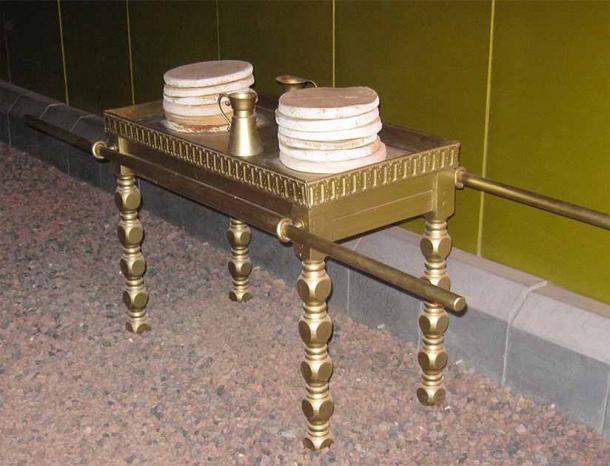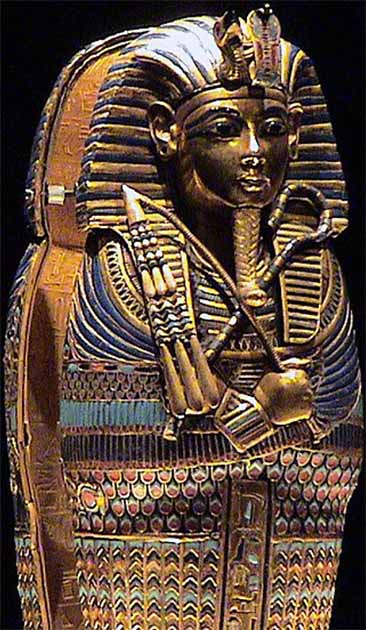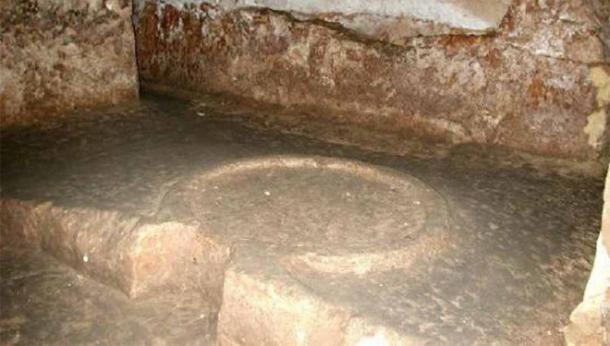
From Babylon to Christianity: Feeding into the Eucharist
There can be no doubt that the Christian sacrament of the Eucharist was derived from Jewish, Babylonian, Assyrian and Egyptian traditions of sun veneration and sun baking methods.
The custom seems to have been widespread in the middle east, an example being the Babylonian practice of offering to their gods a number of different kinds of cakes/bread ( akalu). The Hebrew term for showbread, Lehem ha Panim, is exactly translated by the Assyrian phrase akal pânu, which refers to the Babylonian cake/bread offerings. The Israelites were of course prisoners in Babylon for many decades.
The immediate and obvious parent of the Christian Eucharist was the Israelite ritual of baking “showbread” in their temple.

Table of Showbread, in a full-size replica of the Israelite Tabernacle (Mishkan) in Timna valley, Israel. (Ori229/ CC BY-SA 3.0)
On each sabbath day, twelve newly kneaded loaves made from ground sprouted grains were placed on a special table, decorated with gold in honor of the sun god, against the northern wall of the unroofed sanctuary where they would receive maximum heat from the sun’s rays. Gold cups and utensils were also used. The loaves were known as “Presence Bread” ( Leḥem ha Pānīm) because they were required to be constantly in the presence of the solar deity. (Exodus 25:30).
- American Gods: Rituals & Sacrifices to the All-Powerful Solar Gods
- The Torah: Its History, Use, and Continued Purpose
Unsurprisingly the bread was described as always warm and sweet – warm because of the sun’s heat and sweet because dough made from sprouted grains develops nutritious enzymes and sugars in the malting process.
The loaves were stacked in two piles but separated from each other by a nest of 48 hollow golden tubes, which allowed warm air to circulate between them.
After a week of being thus slowly cooked the loaves were eaten by the priests on the next sabbath and replaced by new loaves.
The Jewish and Christian Incarnations of Showbread
The Torah gave detailed instructions:
“Take the finest grade of wheat flour and bake it into 12 loaves. Each loaf will be made from two-tenths of an eifah (2.7 liters; 1 gallon). Arrange these loaves in two stacks, six loaves to a stack, on the pure table, before God. Put pure frankincense beside these stacks. This will be the memorial portion, a fire-offering to God. Every Sabbath these loaves should be placed before God—it is an eternal covenant that this must come from the children of Israel. The bread will be given to Aaron and his descendants to eat in a holy place, since it is a most holy fire-offering to God. This is an eternal law.”
The Essene Gospel of John also describes a similar process:
“Let the angels of God prepare your bread. Moisten your wheat, that the angels of water may enter it. Then set it in the air, that the angel of air may embrace it. And leave it from morning to evening beneath the sun, that the angel of sunshine may descend upon it. And the blessings of the three angels will soon make the germ of life to sprout in your wheat. Then crush your grain, and make thin wafers, as did your forefathers when they departed out of Egypt, the house of bondage. Put them back again beneath the sun from its appearing, and when it is risen to its highest in the heavens, turn them over on the other side that they may be embraced there also by the angel of sunshine, and leave them there until the sun sets. For the angels of water, and air and of sunshine fed and ripened the wheat in the field, and they likewise must prepare also your bread. And the same sun which, with the fire of life, made the wheat to grow and ripen, must cook your bread with the same fire. For the fire of the sun gives life to the wheat, to the bread, and to the body. But the fire of death kills the wheat, the bread, and the body. And the living angels of the living God serve only living men. For God is the God of the living, and not the God of the dead.”
Like most ancient nations in the Middle East, the Jews worshipped the Sun as a god. The Bible is full of references to the Sun, such as “ Let his Light shine upon you”.
In the Hebrew text of Exodus 33:20, Moses was warned of the risk to eyesight of staring at the Sun when he was told: " You will not be able to see my face, for no human can see Me and live”.
- Demonic Possession and the Ancient Practice of Exorcism on the Rise?
- Ancient Babylonian Tablet Provides Compelling Evidence that the Tower of Babel DID Exist
Instructions in the old testament state that the Israelites’ mobile sanctuary was to be aligned east-west such that the sun’s light could enter, and Christian churches have continued to respect this orientation in the design of their churches. Traditionally there was a large circular window at the east end through which light from the rising sun could pour down upon the priest as he elevated the unleavened wafer which was miraculously re-animated to become “ the body of Christ.”
Jesus was perhaps acknowledging the solar deity when he prayed to “ Our Father which art in heaven”.
St Matthew’s gospel suggests that he inaugurated the Christian eucharist at the springtime Jewish Passover festival. It is reported that:
“While they were eating, Jesus took bread, and when he had given thanks, he broke it and gave it to his disciples, saying, ‘Take and eat; this is my body.’
Then he took a cup, and when he had given thanks, he gave it to them, saying, “Drink from it, all of you. This is my blood of the covenant, which is poured out for many for the forgiveness of sins. I tell you, I will not drink from this fruit of the vine from now on until that day when I drink it new with you in my Father’s kingdom.”
A Tradition of the Egyptians?
The miracle whereby grain sprouts and comes back to life again has been celebrated almost universally and for thousands of years. Grain (still viable) has been found in the tombs of Egyptian pharaohs and the threshing flail combined with a shepherd’s crook comprised their royal insignia which were originally associated with Osiris who was a god of fertility and resurrection. Egyptian religion undoubtedly influenced Jewish traditions. It has even been plausibly suggested that Moses was actually the pharaoh Akhenaten who demoted all the Egyptian gods other than Ra – the Sun God.

The crook and flail on the coffinette of Tutankhamun. (CC BY-SA 2.5)
The Green Man, who frequently adorned medieval churches, is also a widespread image in ancient folklore. Like Osiris, he was said to have been cut into pieces and resurrected in the springtime.
One ancient mystery cult involved a priest plastered with grains who would emerge from a cave when the seeds began to sprout, to the joy of his congregation.
In Greece the springtime resurrection of the goddess Persephone, daughter of Ceres, also celebrated the annual rebirth of nature in general and the sprouting of cereals in particular.
A Symbolic Eating of Flesh
In the Eucharist, Jesus equated his flesh with bread, and his blood with wine. Roman Catholics are required to believe that their communion wafers are actually converted into the flesh of Jesus which they are invited to consume.
Other denominations take a more symbolic interpretation of the words of Jesus. There would have been twelve loaves for the twelve disciples at the “last supper”. The number twelve also reflects the twelve signs of the zodiac which calibrated time for ancient peoples.
The reported words of Jesus make it clear that he was preparing for death as an act of atonement for the sins of his people. The Jewish god was a capricious god who could be jealous and angry if his commandments as communicated via Moses were disobeyed. He spoke in thunder and could inflict storms, lightning, floods, pestilence and death if he was displeased. But it was believed that his anger could be appeased by means of sacrifice, usually of animals, but occasionally of humans. In a biological sense all living creatures survive and thrive by consuming other living creatures. So this was reflected in God being thought of as a hungry god who needed to eat too.
Symbolism With Very Real Roots
Jesus was apparently anticipating his own imminent crucifixion and death at his last supper. Seasonal human sacrifice of community leaders – sometimes voluntary - was not unknown in ancient societies. The patriarch Abraham is said to have been preparing to sacrifice his own son until God told him to kill a ram instead.
The Indian Khonds continued to sacrifice their human meriahs (victims) until the nineteenth century in order to appease the earth goddess and induce a successful growing season.

In prehistoric Malta stone altars decorated with cereals were used to sprout grains that were moistened and exposed to the sun. Carved stone models of the cereal goddess were used by the priests to encourage the sprouting of grains. (Author provided)
Some early Gnostic Christian groups may have practiced ritual cannibalism in blind obedience to an interpretation of the words of Jesus. The Carpocratians were a sect which were alleged to consume unwanted babies in underground catacombs. Circular stone altars known as agape tables carved perhaps for this very purpose may be seen underground in Maltese catacombs. They feature a rim to contain the blood of the sacrifice with a lip out of which the blood could have poured into a drinking vessel.

Images of cereal goddess and stone altar from Malta. (Author provided)
In prehistoric Malta stone altars decorated with cereals were used to sprout grains that were moistened and exposed to the Sun. Carved stone models of the cereal goddess were used by the priests to encourage the sprouting of grains.
Top image: Hands of priest raise sacramental bread or the Eucharist under light. Source: Creativa Images/Adobe Stock
Stephen Childs is also the author of Stone Circles Explained.
References
Osman, Ahmed, 1990. “Moses Pharaoh of Egypt”. Grafton
Jacobs, Joseph & Hirsch, Emil G., ‘Jewish Encyclopedia – Showbread’. Available at: https://www.jewishencyclopedia.com/articles/13611-showbread
Smith, Andrew P. 2015 ‘The Secret History of the Gnostics: Their Scriptures, Beliefs and Traditions’, Watkins Media Limited \. Available at: https://books.google.com.ec/books?id=U4FpCgAAQBAJ&pg=PT73&redir_esc=y#v=onepage&q&f=false
















Comments
As it is written in the bible: Already Moses knew the wisdom of the Egyptians. And he was powerful in it in his deeds and words. So was Jesus.
It can be proven that the cross was a symbol also of the early Christians. This is also said by the bible!
Shining light and the sacrifice of children are mentioned, but not the Shining One to whom children are ritually sacrificed (ie. Lucifer).
I watched a BBC drama last night (a rare occurrence for television is increasingly untrustworthy) and took no time at all to be disturbed by the somewhat unnecessary fictional reference to a 18th century Witch burned for killing and eating children.
There's a fine line between history (including the fictionalisation of it for dramatic effect) and the rewriting of history. The latter is a favourite past-time of the Luciferian community.
Most people do not see that line or the Luciferians themselves, let alone ever notice when it is being crossed. It is easy to be swept along by it all thinking everything to be all right. That is a form of thinking without thinking that the Luciferian community is keenly encouraging amongst others.
It is one thing to vaguely understand the general process of propaganda and another completely in noticing it when subjected to it or swept up in spreading it oneself.
You and michael tsarion both see this.. i see it predicted in isaiah 4..
infinitesimal waveparticles comprise what we call home the earth
manipulatable by thought ability supressed in humans since birth